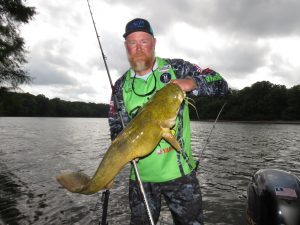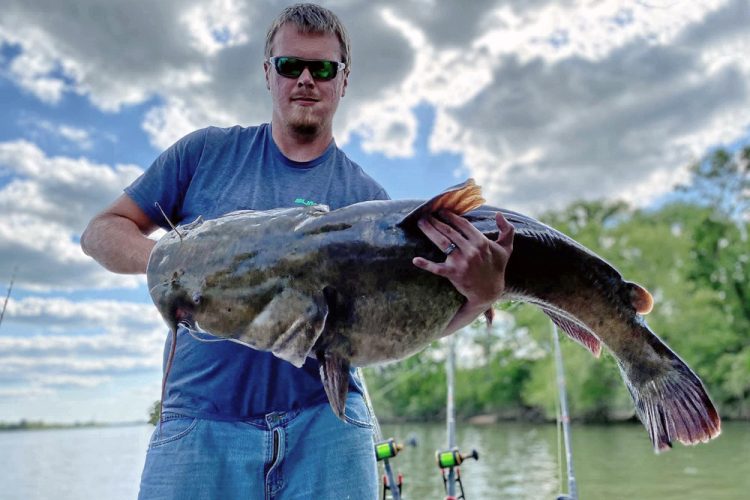Catching trophy catfish like this one being held by Josh Brown of Backwoods Catfishing Guide Service can be done if you pay attention to a few details pertaining to where and how you present the proper baits. (Photo courtesy of Josh Brown)
Post-Spawn Flatheads
By Rodney Crimm
Whether you are looking for flatheads for a fish fry or for that trophy of a lifetime, here are some tips and tactics to help.
August marks the beginning of a prime period to target flathead catfish. By this time, these fish are recovering from the rigors of the spawn and actively feeding to regain lost weight. With the right location and proper bait presentation, you might land your biggest flathead ever or catch enough for a delicious family fish fry.

Targeting trophy-sized flatheads means being more strategic about where and when you fish. These predators prefer deep holes with rocky bottoms, submerged logs or other structure, especially near creek mouths.
According to Josh Brown of Guntersville, Alabama, owner of Backwoods Catfishing Guide Service, “If you are fishing during the day, aim for deeper holes with obstructions or areas near creek mouths. Get within 100 feet of that structure, and cast your baits as close as you can, within five feet if possible.”
For nighttime fishing, Brown recommends targeting shallow flats adjacent to deeper holes.
“Flatheads move into shallow water under the cover of darkness to hunt,” he says. He notes that flatheads in the Tennessee River where he guides tend to respond better to live bait during the day, while at night, either live or cut-bait can be effective.
Brown also said that there are times when you may find flatheads suspending in submerged structures. To catch those fish, you may have to place some of your baits at different depths until you find where the fish are located within the structure, then move your baits to that depth and suspend them to target those fish.
Brown prefers simple but effective setups like the Carolina rig or Santee Cooper rig. He prefers a 100-pound monofilament leader line to give strength and abrasion resistance, allowing him to pull trophy-sized fish out of heavy cover whether he is fishing from a boat or from the bank.
For bank anglers, he suggests using contour maps such as those found in the Navionics app to locate ledges or deep holes near shallow flats. If contour maps are not available, look for inside bends in the river where slower current collects debris and creates structure.
From a boat, you can also suspend baits three to four feet above promising structure. Bank anglers can use a large slip float with an adjustable line stop to set the bait at the desired depth. If you are doing this type of float fishing in a river with current, then you should cast above the area you think the fish are in and let the float move with the current, presenting the bait at the desired depth. If you are trying to use a float rig in still water conditions, you might try casting upwind of the location and let the wind move your bait where you suspect fish might be.
Jay Gallup of Caledonia, Mississippi, a longtime B’n’M Pro Staff member, is also a strong advocate of live bait.

“Start by locating deeper holes with rocky or uneven bottoms where fish can hide,” he says. He prefers using a 7000 series spinning reel paired with a 10-foot B’n’M Silver Cat Magnum rod, which allows him to cast live shad, a choice bait, without losing the bait midcast. He favors a three-way rig with a three-foot lead line and a one-foot hook leader to prevent the bait from swimming into and snagging on the structure.
Brown and Gallup emphasize that using electronics is not always about spotting fish directly. Often, it is more important to find areas where fish are likely to be hiding or waiting to ambush prey. Look for structure near deeper water, whether it is visible above the surface or revealed through sonar.
If you are limited to bank fishing, focus on areas that provide easy access to deep water or structure. Use contour maps when possible, and do not overlook nighttime fishing in shallower zones where flatheads may be hunting. A well-placed bait near productive structure is often all it takes to entice a flathead. So, you shouldn’t let the lack of owning a boat cause you to think you cannot catch trophy or eater-size fish. I grew up fishing from the bank below the tailrace of Grenada Lake with my dad. We caught plenty of flatheads, including so trophy-size fish, while sitting on those rocks and using several of the same tactics mentioned here.
Summertime flathead catfishing rewards patience, preparation and a bit of strategy. Whether you are chasing trophies or just looking for a few fish for the fryer, focus on structure, time your outings well, and use the right bait and gear. Then hang on tight because once a flathead strikes, you are in for one of freshwater’s toughest fights.
(Rodney Crimm of Pontotoc, Mississippi is a B’n’M Pro Staff member, catfish tournament angler and lifelong outdoorsman with a passion for catching trophy catfish.)



